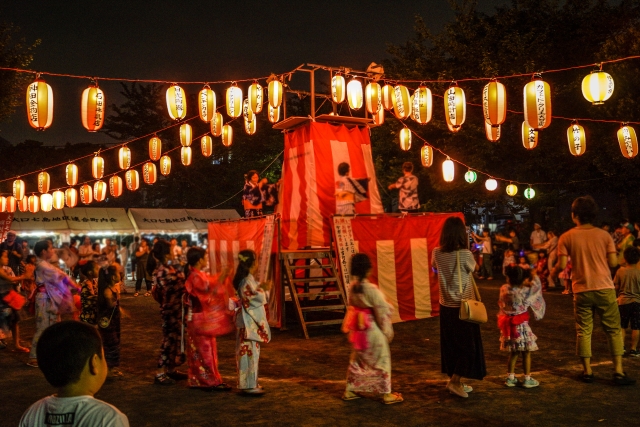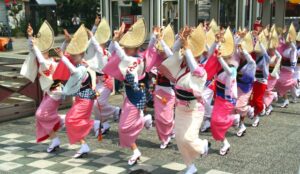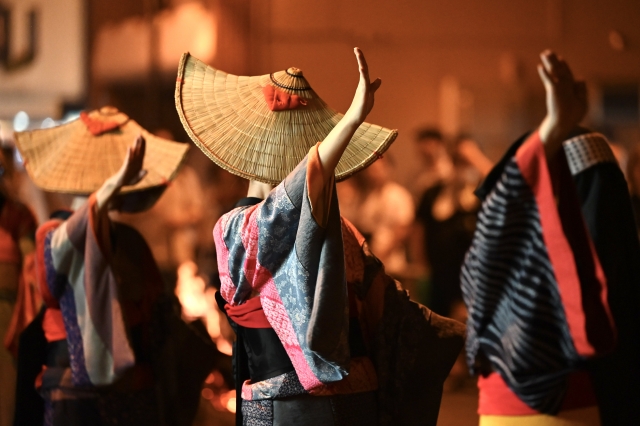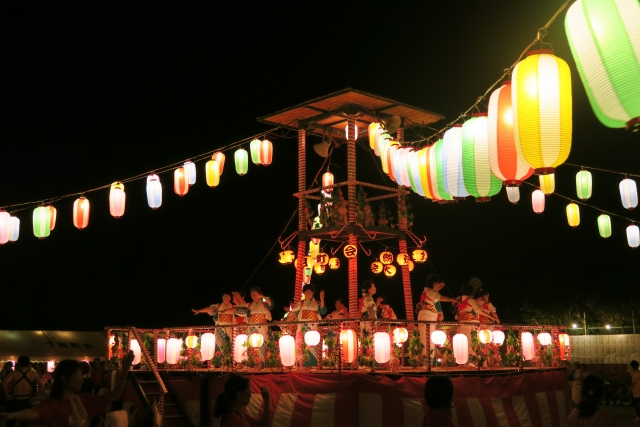Bon Odori — A Timeless Celebration That Colors the Japanese Summer
As the summer sky begins to turn crimson at dusk, the distant sounds of drums and flutes start to echo through the air.
People in yukata—light cotton robes—gather slowly in an open square lit by softly glowing lanterns. Before long, a circle of dancers naturally forms, swaying to the rhythm of the music.
Bon Odori is, without question, one of the most iconic and beloved traditions of the Japanese summer.
Whether in the heart of a bustling city or a quiet rural village, it creates a dreamlike stage that exists only on summer nights. Simply being there invites a sense of nostalgia—a gentle unraveling of the heart.
Let yourself be carried by the sound of drums, flutes, and voices. Even if you don’t know the steps, you’ll soon find yourself blending into the circle.
Whether you’re dancing or simply watching, everyone is welcome to enjoy the moment in their own way.
This warmth and inclusiveness are part of Bon Odori’s enduring charm.
A Dance of Prayer to Welcome the Spirits
The origins of Bon Odori are subject to various theories, but one of the most compelling points to a practice called odori-nenbutsu, or “dancing with prayer,” which was spread by the Buddhist monk Kūya during the Heian period.
This form of devotional dance—chanting while moving—eventually became linked with Obon, the custom of welcoming ancestral spirits, and evolved into what we now know as Bon Odori.
Originally a religious ritual meant to honor the spirits of the dead, its sacred tone gradually softened over time. Today, it is celebrated more as a community event—a vibrant and welcoming part of local summer festivals.

People in yukata gather gently, and a circle of dance naturally begins to form.
And yet, even now, when people of all ages come together to dance while upholding their region’s traditions, you can still sense the weight of a history that has long connected people across generations.
A Tapestry of Regional Expression
Though it’s called Bon Odori throughout the country, its forms vary greatly from place to place.
The rhythm, choreography, attire—and even the nature of the prayers embodied in the dance—are deeply distinct.
In some regions, the dance is bold and energetic; in others, it is graceful and serene. Over centuries, Bon Odori has taken root in each locale, shaped by the land, the lives of its people, and their sense of beauty and spirituality.
Every dance bears the imprint of its region’s climate, culture, and collective memory.
Awa Odori (Tokushima Prefecture)

Awa Odori, one of Japan’s three major Bon dances.
※For more on Awa Odori, see the separate article: Dancing Spirits: 400 Years of Memory in Awa Odori
Known for the famous chant, “Odoru ahō ni miru ahō” (“The dancers are fools, and so are the watchers”), Awa Odori boasts a 400-year history and is considered one of the three great Bon Odori festivals in Japan.
The dance is clearly divided into men’s and women’s styles.
The men’s dance is characterized by powerful, low stances and energetic movements, while the women’s dance features elegant, refined gestures and graceful footwork.
As group after group of dancers fills the streets beneath a canopy of lanterns, the spectacle is nothing short of breathtaking.
※Read about Tokushima Prefecture: A Gateway to Shikoku Rich in Culture and Scenic Beauty
【Aho-ren – A breathtakingly synchronized Awa Odori performance from 2022.】
Gujo Odori (Gifu Prefecture)
Held in Gujo City, this is Japan’s longest Bon Odori festival, lasting over 30 nights. Its climax—the Tetsuya Odori or “All-Night Dance”—fills the town with vibrant energy as people dance until dawn.
There are over ten types of dances, including Kawasaki, Harukoma, Sanbyaku, and Yacchiku. Locals and visitors alike are welcomed into the circle, creating an atmosphere of joyful unity.
The rhythmic clatter of wooden geta sandals echoes through the warm summer nights, blending tradition and festivity into an unforgettable celebration.
※Read about Gifu Prefecture: A Land of History and Craftsmanship Nurtured by Mountains and Rivers
【Gujo Odori 2024 – The electrifying all-night dance that captivates with its unbroken rhythm and festive spirit.】
Nishimonai Bon Odori (Akita Prefecture)
With over 700 years of history, this elegant and otherworldly dance from Ugo Town in Akita Prefecture is designated an Important Intangible Folk Cultural Asset of Japan.
Dancers wear striking costumes made of colorful silk scraps and veil their faces with black hoods or hikosa zukin, deep cowls that add to the air of mystery. As they move silently through the darkness, their silhouettes seem to blur the line between the worlds of the living and the dead.
※Read about Akita Prefecture: Traditions and Daily Life in a Snow Country

It is characterized by dancers wearing woven hats low over their faces.
Accompanied by the slow, haunting tones of the ondo and ganke (local musical accompaniments), the dancers drift past one another in a trance-like flow, drawing the viewer into a realm of quiet beauty and spiritual resonance.
【Nishimonai Bon Odori in Akita】
Tokyo Ondo (Tokyo)
First released as a popular song in 1931, Tokyo Ondo quickly spread across Japan via radio and records, and remains beloved by all generations today.
Its simple hand-clapping choreography makes it easy for anyone to learn, and it has become a staple of neighborhood festivals and school events throughout Tokyo.
On summer evenings, children in yukata dancing under a twilight sky create a scene that feels like a preserved memory—an enduring image of Tokyo’s own summer nostalgia.
※Read about Tokyo: A Global Metropolis Where Tradition Meets Innovation
Sōma Bon Uta (Fukushima Prefecture)
Originally sung to console the spirits of warriors who fell in battle, Sōma Bon Uta carries a poignant, melancholic melody that resonates deeply with listeners. Its solemn and deliberate movements set it apart from other Bon Odori, lending it a quiet dignity.
In the Sōma region, it is also closely associated with Sōma Nomaoi, a traditional equestrian festival and designated Important Intangible Folk Cultural Property. Here, the ancestral reverence that forms the spiritual core of Bon Odori remains vividly alive.
Through this dance, the past and the present seem to quietly meet, forming a sacred moment of remembrance.
※Read about Fukushima Prefecture : A Tapestry of Diverse Landscapes Woven by Three Regions
【Sōma Bon Uta | Hie Shrine Bon Odori Festival 2025】
Each of these dances is woven with the stories of its people—their land, their lives, and their hearts.
No matter the region, Bon Odori carries the weight of time, passed down through generations with unwavering care.
And perhaps, within each of us, there lingers a memory of Bon Odori from childhood—of circling steps beneath lanterns, of music echoing into the summer night.
That memory may be one of the truest landscapes of summer in Japan.





コメント